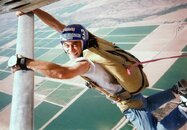if you compare to skydiving, you have to factor in the training style done if they have access to a wind tunnel first. Without a wind tunnel they are very different, and would be comparable to teaching scuba diving if the only water you had access to was 150ft down and there was no pools or shallow confined water to train in.
When you add wind tunnels to sky diving, they give you a quick down and dirty of how to not die, then let you play in the wind tunnels for quite a while to "figure it out". Then a bit more discussion on how not to die when you actually jump out of the plane and how to land safely, then you do it. Comparable to how to make the adjustment from diving in a pool where something going wrong is highly unlikely, to doing your OWT on a charter boat.
Scuba is also a tiered sport where as skydiving is pretty much, your ass is jumping out of a plane. Doesn't particularly matter if it's at 6000ft with an almost immediate deployment of the chute for training dives, or 18000ft, once that chute is open it is all the same dive and you're going 115mph assuming belly down position prior to deploying that chute regardless of how high you are *no halo jumping, but even that is pretty standard once you get below 15k feet, just have to deal with low O2 and some other things*.
Scuba is much more variable where you can have a nice pretty 30 ft reef dive where not a whole lot can go wrong and you might as well be in a pool, or you can be doing a drift dive or 120ft wreck dive in high current. Very different atmospheres. The agencies have dumped the courses down to basically be for 30ft reef diving, which is why the training/briefing is comparable to that of indoor skydiving.
Once you get into "real diving" the on deck discussions get a lot more intense and the land training gets a lot more intense. Cave training has lectures every night and land drills almost every day. Since the diving industry is out to make money, if they did that at recreational levels, there would be a lot less people diving because it removes the instant satisfaction of the sport which is what PADI and the Dive Shops are banking on, get them in, steal all of their money, spit them out, start over. Skydiving has a much higher retention rate, but a lot lower certification rate. This is what diving was 30+ years ago, but not anymore.
PADI started certifying in 1967. It took them until 1982 to certify the amount of divers that it certified in 2013 *right under 1m*. It took them until the end of 1991 to certify the amount of divers they certified in the 4 year period from 2010-2013. They certified in the last 4 years, the same amount of divers they certified in the first 25 years of the organization. They currently represent a 50% marketshare in the industry certifying almost 1m new members each year and have pumped out over 22 million certifications since 1967. There are not currently 22 million active divers in the world.
Not sure about skydiving, I work with DoD for chute design but not in the recreational sector. Looking at USPA, they average right around 35k memberships/year for the last 5 years, but it's not up much from the 30k ish/year starting in 1990. Granted it's double that from the 70's and 80's, but scuba followed a similar trend just on a different order of magnitude. With membership that low, they have a much higher retention percentage and much more dedicated people. Think of how many skydivers you know and how many of them dive regularly. People will get certified on scuba, take maybe one trip per year, most of the time it is less than that. You can't do that in skydiving because it is much more dangerous than easy recreational scuba diving is despite having lower fatality rates.
Sorry for the long winded posts, but while scuba used to be a fairly decent comparison to skydiving back in the 60's-80's, recreational diving needs to be compared to indoor skydiving now while technical diving is a more fair comparison to actual skydiving.




